 |
 |
 |
| |
Food Insecurity and Frailty among Women
Living with or At-risk for HIV in the U.S. - 40% WIHS Women Have Food Insecurity - where us Ryan White Care Act? - No Safety Net
|
| |
| |

Download the PDF here
Download the PDF here
10th International Workshop on HIV and Aging, October 10-11, 2019, New York
Reported by Jules Levin
Judy Y. Tan1, Edward A. Frongillo, PhD2, Lila Sheira, MPH3, Leah H. Rubin4, Kathryn Anastos, MD5, Daniel Merenstein, MD6, Mardge H. Cohen, MD7, Adaora A. Adimora, MD8, Ighovwerha Ofotokun, MD, MSc9, and Sheri D. Weiser, MD, MPH1,4
1University of California, San Francisco (UCSF), Center for AIDS Prevention Studies, USA
2University of South Carolina, Department of Health Promotion, Education, and Behavior, USA
3UCSF, Division of HIV, ID and Global Medicine, 4Johns Hopkins University, Departments of Neurology and Epidemiology, USA
5Albert Einstein College of Medicine, Departments of Medicine, USA
6Georgetown University Medical Center, USA; 7Department of Medicine, Stroger Hospital, USA
8University of North Carolina at Chapel Hill, 9School of Medicine, Emory University, USA
HIV-infected women may be particularly susceptible to food insecurity [1]. The prevalence of WIHS participants with very low food security (12%) is more than twice as high as the prevalence
of households in the U.S. general population with very low food security (5%) [10].
Participants had a mean age of 49 (standard deviation (SD): 8.6). The sample was predominantly non-Hispanic African- American (67%); 18% were Hispanic, 11% were non-Hispanic
white, and 3.7% identified as other (Supplementary Table I). Two-fifths (40%) reported food insecurity: 15% marginal food security, 13% low, and 12% very low. Nearly a fifth (18%) were currently receiving food aid. Of participants with very low food security, 31% were receiving governmental food aid, and 20% were receiving non-governmental food aid. More than half (58%) had an undetectable viral load, and few had CD4+ counts below 200 (9%). food insecurity was associated with 2.08 times higher HIV-1 viral load (95% confidence interval (CI) 1.04, 4.15, p = 0.04) (Table 1). In a multivariable linear regression model, food insecurity was associated with an average 42.10 cells/mm3 lower mean CD4+ count (CI - 81.16, - 3.03; p = 0.03) after adjusting for covariates (Table 1).
The limited receipt of food assistance in our sample highlights the need to improve access to food assistance for HIV-infected women on both a clinical and policy level. It is unclear based on the data available if poor access to food assistance was related to a lack of integration of food insecurity assessment into routine HIV clinical care, or a lack of resources available for addressing food insecurity. Although collection of food insecurity data is required for food and nutrition providers for Ryan White Part A beneficiaries in some regions, it is not collected routinely throughout other aspects of the Ryan White Program [2]. Integration of food insecurity assessments into comprehensive HIV care, particularly for vulnerable patients such as Ryan White
......Women in the general population experience more food insecurity than men. Few studies have examined food insecurity's impact on HIV treatment outcomes among women. We examined the association between food insecurity and HIV outcomes in a multi-site sample of HIV-infected women in the United States (n = 1154). Two-fifths (40%) of participants reported food insecurity. Food insecurity is defined as the limited or uncertain availability of nutritionally adequate, safe foods, or the inability to acquire personally acceptable food in socially acceptable ways [1]. Food insecurity affects about a quarter to half of HIV-infected adults in the United States (U.S.) compared to 14% of the general population [2, 3]. Food insecurity is associated with lower physical health status, incomplete viral load suppression, and lower CD4+ counts [2, 4, 5].
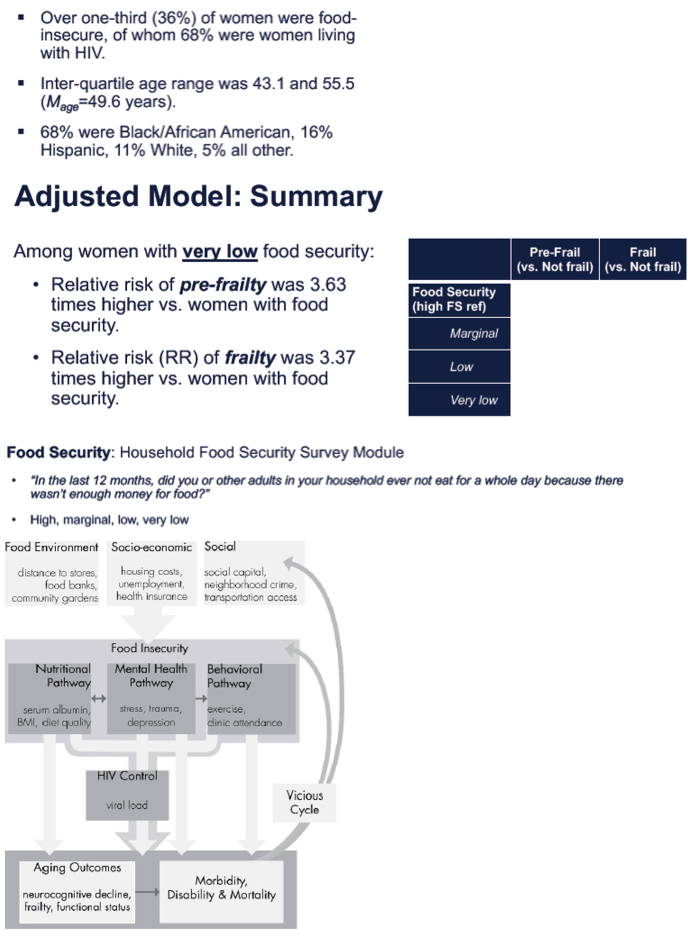
10th International Workshop on HIV and Aging, October 10-11, 2019, New York
Reported by Jules Levin
Judy Y. Tan1, Edward A. Frongillo, PhD2, Lila Sheira, MPH3, Leah H. Rubin4, Kathryn Anastos, MD5, Daniel Merenstein, MD6, Mardge H. Cohen, MD7, Adaora A. Adimora, MD8, Ighovwerha Ofotokun, MD, MSc9, and Sheri D. Weiser, MD, MPH1,4
1University of California, San Francisco (UCSF), Center for AIDS Prevention Studies, USA
2University of South Carolina, Department of Health Promotion, Education, and Behavior, USA
3UCSF, Division of HIV, ID and Global Medicine, 4Johns Hopkins University, Departments of Neurology and Epidemiology, USA
5Albert Einstein College of Medicine, Departments of Medicine, USA
6Georgetown University Medical Center, USA; 7Department of Medicine, Stroger Hospital, USA
8University of North Carolina at Chapel Hill, 9School of Medicine, Emory University, USA
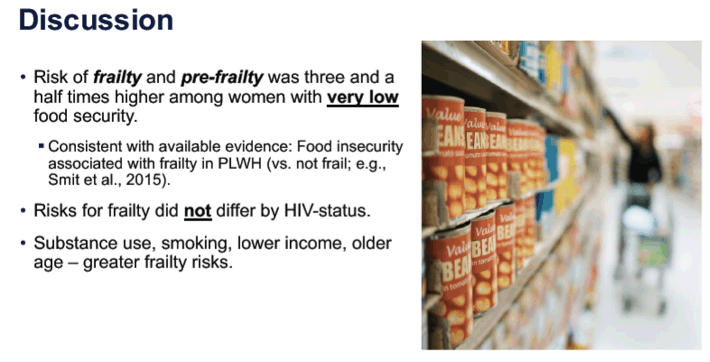
program abstract
Food insecurity and frailty among women in the US
Tan J1, Weiser S2
1University of California San Francisco, Center for AIDS Prevention Studies, San Francisco, United States, 2Division of HIV, ID and Global Medicine, University of California, San Francisco (UCSF), San Francisco, United States
Background: Frailty is frequently observed among older people living with HIV, and food insecurity is associated with frailty in the general population. Little is known about the associations between food insecurity and frailty among HIV-infected women, who may be particularly vulnerable to the impact of food insecurity with increased age. The goal of this study was to assess associations between food insecurity and frailty among women with or at risk of HIV-infection.
Methods: From 2017-2018, 1324 (900 HIV-seropositive, 424 HIV-seronegative) participants from the Women's Interagency HIV Study participated in the five measures comprising the Fried Frailty Index. Women were subsequently categorized as not frail, pre-frail, or frail. Participants also completed a measure of food insecurity (U.S. Household Food Security Survey Module). Multinomial logistic regression models were conducted to examine cross-sectional associations between food insecurity and frailty after adjusting for socio-demographic, behavioral, and HIV status.
Results: Over one-third (36%) of women were food-insecure, of whom 68% were women living with HIV. In the fully adjusted model including HIV-status, the relative risk (RR) of frailty for women with very low food security was 3.37 times higher than for women with food security (95% CI [1.38 - 8.24], p<0.01), and the corresponding relative risk of pre-frailty was 3.63 (95% CI [1.76 - 7.51], p<0.01). Higher income was associated with lower relative risks of frailty or pre-frailty (p<0.01). Similarly, older age was associated with higher relative risk of frailty (RR=1.06, 95% CI [1.03 - 1.09], p<0.001). Women living with HIV were not more or less at risk for frailty compared to HIV-negative women.
Conclusions: Very low food security was associated with higher risks of being frail or pre-frail among HIV-infected and at-risk women. HIV status was not an issue for frailty. Longitudinal research is needed to investigate directionality and potential mediators, such as stress and poor nutritional status.

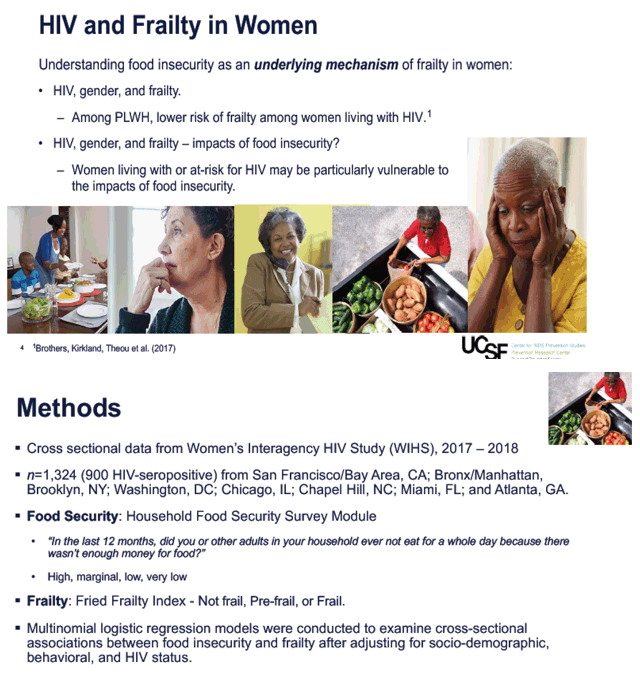
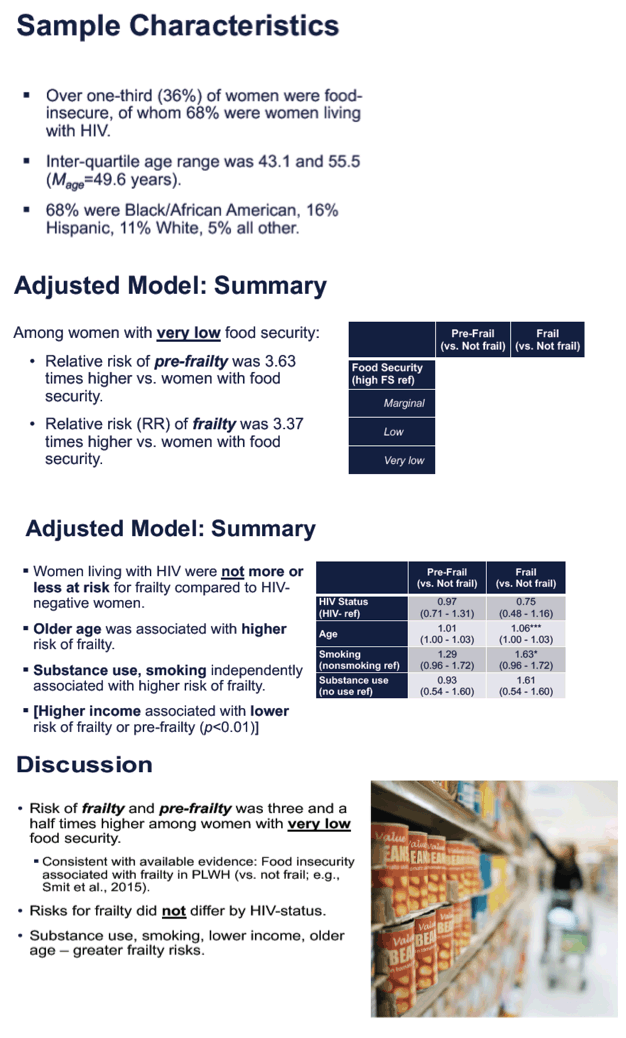
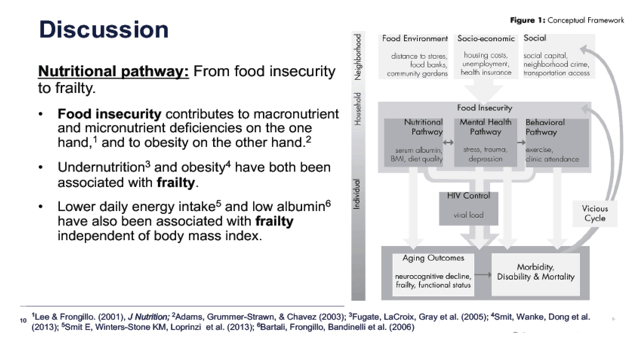
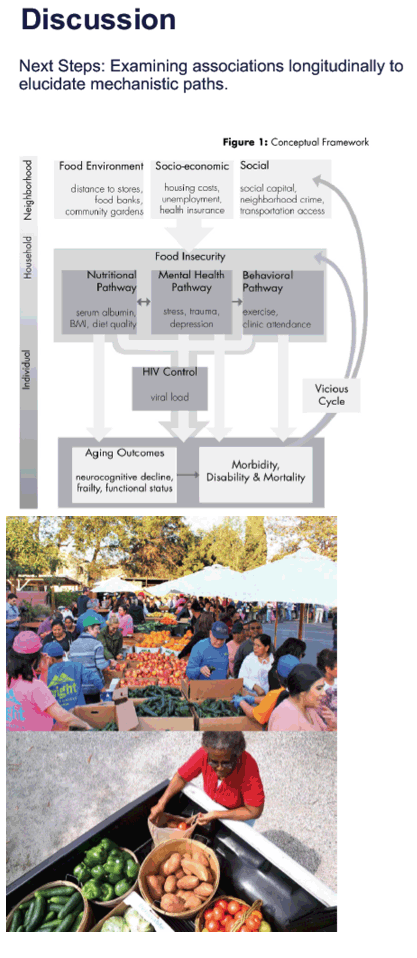

|
| |
|
 |
 |
|
|